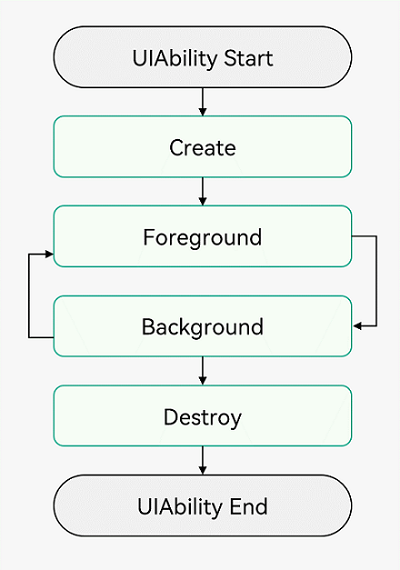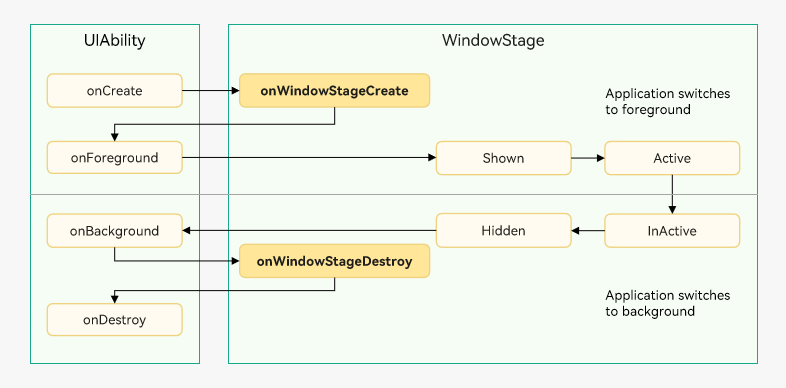UIAbility Lifecycle
Overview
When a user opens or switches to and from an application, the UIAbility instances in the application transit in their different states. The UIAbility class provides a series of callbacks. Through these callbacks, you can know the state changes of the UIAbility instance.
The lifecycle of UIAbility has four states: Create, Foreground, Background, and Destroy, as shown in the figure below.
Figure 1 UIAbility lifecycle states

Description of Lifecycle States
Create
The Create state is triggered when the UIAbility instance is created during application loading. It corresponds to the onCreate() callback. In this callback, you can perform page initialization operations, for example, defining variables or loading resources.
import UIAbility from '@ohos.app.ability.UIAbility';
import AbilityConstant from '@ohos.app.ability.AbilityConstant';
import Want from '@ohos.app.ability.Want';
export default class EntryAbility extends UIAbility {
onCreate(want: Want, launchParam: AbilityConstant.LaunchParam) {
// Initialize the page.
}
// ...
}
NOTE
Want is used as the carrier to transfer information between application components. For details, see Want.
WindowStageCreate and WindowStageDestroy
After the UIAbility instance is created but before it enters the Foreground state, the system creates a WindowStage instance and triggers the onWindowStageCreate() callback. You can set UI loading and WindowStage event subscription in the callback.
Figure 2 WindowStageCreate and WindowStageDestroy

In the onWindowStageCreate() callback, use loadContent() to set the page to be loaded, and call on('windowStageEvent') to subscribe to WindowStage events, for example, having or losing focus, or becoming visible or invisible.
import UIAbility from '@ohos.app.ability.UIAbility';
import window from '@ohos.window';
export default class EntryAbility extends UIAbility {
// ...
onWindowStageCreate(windowStage: window.WindowStage) {
// Subscribe to the WindowStage events (having or losing focus, or becoming visible or invisible).
try {
windowStage.on('windowStageEvent', (data) => {
let stageEventType: window.WindowStageEventType = data;
switch (stageEventType) {
case window.WindowStageEventType.SHOWN: // Switch to the foreground.
console.info('windowStage foreground.');
break;
case window.WindowStageEventType.ACTIVE: // Gain focus.
console.info('windowStage active.');
break;
case window.WindowStageEventType.INACTIVE: // Lose focus.
console.info('windowStage inactive.');
break;
case window.WindowStageEventType.HIDDEN: // Switch to the background.
console.info('windowStage background.');
break;
default:
break;
}
});
} catch (exception) {
console.error('Failed to enable the listener for window stage event changes. Cause:' +
JSON.stringify(exception));
}
// Set the page to be loaded.
windowStage.loadContent('pages/Index', (err, data) => {
// ...
});
}
}
NOTE
For details about how to use WindowStage, see Window Development.
Before the UIAbility instance is destroyed, the onWindowStageDestroy() callback is invoked to release UI resources. In this callback, you can unsubscribe from the WindowStage events.
import UIAbility from '@ohos.app.ability.UIAbility';
import window from '@ohos.window';
import { BusinessError } from '@ohos.base';
export default class EntryAbility extends UIAbility {
windowStage: window.WindowStage | undefined = undefined;
// ...
onWindowStageCreate(windowStage: window.WindowStage) {
this.windowStage = windowStage;
// ...
}
onWindowStageDestroy() {
// Release UI resources.
// Unsubscribe from the WindowStage events such as having or losing focus in the onWindowStageDestroy() callback.
try {
if (this.windowStage) {
this.windowStage.off('windowStageEvent');
}
} catch (err) {
let code = (err as BusinessError).code;
let message = (err as BusinessError).message;
console.error(`Failed to disable the listener for windowStageEvent. Code is ${code}, message is ${message}`);
};
}
}
Foreground and Background
The Foreground and Background states are triggered when the UIAbility instance is switched to the foreground and background, respectively. They correspond to the onForeground() and onBackground() callbacks.
The onForeground() callback is triggered when the UI of the UIAbility instance is about to become visible, for example, when the UIAbility instance is about to enter the foreground. In this callback, you can apply for resources required by the system or re-apply for resources that have been released in the onBackground() callback.
The onBackground() callback is triggered when the UI of the UIAbility instance is about to become invisible, for example, when the UIAbility instance is about to enter the background. In this callback, you can release unused resources or perform time-consuming operations such as saving the status.
For example, there is an application that requires location access and has obtained the location permission from the user. Before the UI is displayed, you can enable location in the onForeground() callback to obtain the location information.
When the application is switched to the background, you can disable location in the onBackground() callback to reduce system resource consumption.
import UIAbility from '@ohos.app.ability.UIAbility';
export default class EntryAbility extends UIAbility {
// ...
onForeground() {
// Apply for the resources required by the system or re-apply for the resources released in onBackground().
}
onBackground() {
// Release unused resources when the UI is invisible, or perform time-consuming operations in this callback,
// for example, saving the status.
}
}
Destroy
The Destroy state is triggered when the UIAbility instance is destroyed. You can perform operations such as releasing system resources and saving data in the onDestroy() callback.
The UIAbility instance is destroyed when terminateSelf() is called or the user closes the instance in the system application Recents.
import UIAbility from '@ohos.app.ability.UIAbility';
export default class EntryAbility extends UIAbility {
// ...
onDestroy() {
// Release system resources and save data.
}
}